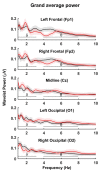It Takes Two: Interpersonal Neural Synchrony Is Increased after Musical Interaction
- PMID: 35326366
- PMCID: PMC8946180
- DOI: 10.3390/brainsci12030409
It Takes Two: Interpersonal Neural Synchrony Is Increased after Musical Interaction
Abstract
Music's deeply interpersonal nature suggests that music-derived neuroplasticity relates to interpersonal temporal dynamics, or synchrony. Interpersonal neural synchrony (INS) has been found to correlate with increased behavioral synchrony during social interactions and may represent mechanisms that support them. As social interactions often do not have clearly delineated boundaries, and many start and stop intermittently, we hypothesize that a neural signature of INS may be detectable following an interaction. The present study aimed to investigate this hypothesis using a pre-post paradigm, measuring interbrain phase coherence before and after a cooperative dyadic musical interaction. Ten dyads underwent synchronous electroencephalographic (EEG) recording during silent, non-interactive periods before and after a musical interaction in the form of a cooperative tapping game. Significant post-interaction increases in delta band INS were found in the post-condition and were positively correlated with the duration of the preceding interaction. These findings suggest a mechanism by which social interaction may be efficiently continued after interruption and hold the potential for measuring neuroplastic adaption in longitudinal studies. These findings also support the idea that INS during social interaction represents active mechanisms for maintaining synchrony rather than mere parallel processing of stimuli and motor activity.
Keywords: electroencephalography (EEG); entrainment; hyperscanning; interbrain phase coherence; interpersonal neural synchrony; interpersonal synchrony; music; neuroplasticity.
Conflict of interest statement
The authors declare no conflict of interest.
Figures






Similar articles
-
Interpersonal neural synchrony and mental disorders: unlocking potential pathways for clinical interventions.Front Neurosci. 2024 Mar 11;18:1286130. doi: 10.3389/fnins.2024.1286130. eCollection 2024. Front Neurosci. 2024. PMID: 38529267 Free PMC article.
-
Dynamics in interbrain synchronization while playing a piano duet.Ann N Y Acad Sci. 2023 Dec;1530(1):124-137. doi: 10.1111/nyas.15072. Epub 2023 Oct 12. Ann N Y Acad Sci. 2023. PMID: 37824090
-
Spontaneous dyadic behavior predicts the emergence of interpersonal neural synchrony.Neuroimage. 2023 Aug 15;277:120233. doi: 10.1016/j.neuroimage.2023.120233. Epub 2023 Jun 20. Neuroimage. 2023. PMID: 37348621
-
Exploring the impact of manual and automatic EEG pre-processing methods on interpersonal neural synchrony measures in parent-infant hyperscanning studies.J Neurosci Methods. 2025 May;417:110400. doi: 10.1016/j.jneumeth.2025.110400. Epub 2025 Feb 18. J Neurosci Methods. 2025. PMID: 39978481
-
Hyperscanning Studies on Interbrain Synchrony and Child Development: A Narrative Review.Neuroscience. 2023 Oct 15;530:38-45. doi: 10.1016/j.neuroscience.2023.08.035. Epub 2023 Aug 30. Neuroscience. 2023. PMID: 37657749 Review.
Cited by
-
Physiological synchrony and shared flow state in Javanese gamelan: positively associated while improvising, but not for traditional performance.Front Psychol. 2023 Aug 17;14:1214505. doi: 10.3389/fpsyg.2023.1214505. eCollection 2023. Front Psychol. 2023. PMID: 37663327 Free PMC article.
-
Interpersonal neural synchrony and mental disorders: unlocking potential pathways for clinical interventions.Front Neurosci. 2024 Mar 11;18:1286130. doi: 10.3389/fnins.2024.1286130. eCollection 2024. Front Neurosci. 2024. PMID: 38529267 Free PMC article.
-
The Co-Construction of an Elegant Ending-Polyphonic Musical Intervention in Palliative Care: A Case Study.Behav Sci (Basel). 2022 Oct 14;12(10):392. doi: 10.3390/bs12100392. Behav Sci (Basel). 2022. PMID: 36285961 Free PMC article.
-
Music and Brain Circuitry: Strategies for Strengthening Evidence-Based Research for Music-Based Interventions.J Neurosci. 2022 Nov 9;42(45):8498-8507. doi: 10.1523/JNEUROSCI.1135-22.2022. J Neurosci. 2022. PMID: 36351825 Free PMC article. Review.
-
Environmental effects on inter-brain coupling: a systematic review.Front Hum Neurosci. 2025 Jul 31;19:1627457. doi: 10.3389/fnhum.2025.1627457. eCollection 2025. Front Hum Neurosci. 2025. PMID: 40822293 Free PMC article. Review.
References
-
- Delaherche E., Boucenna S., Karp K., Michelet S., Achard C., Chetouani M. Proceedings of the IAPR Workshop on Multimodal Pattern Recognition of Social Signals in Human-Computer Interaction. Springer; Berlin/Heidelberg, Germany: 2012. Social Coordination Assessment: Distinguishing between Shape and Timing; pp. 9–18.
-
- Kinsbourne M., Helt M. The Neuropsychology of Autism. Oxford University Press; Oxford, UK: 2011. Entrainment, Mimicry, and Interpersonal Synchrony; pp. 339–365.
-
- Chetouani M., Delaherche E., Dumas G., Cohen D. Social Signal Processing. Cambridge University Press; Cambridge, UK: 2017. 15 Interpersonal Synchrony: From Social Perception to Social Interaction; p. 202.
-
- Mogan R., Fischer R., Bulbulia J.A. To Be in Synchrony or Not? A Meta-Analysis of Synchrony’s Effects on Behavior, Perception, Cognition and Affect. J. Exp. Soc. Psychol. 2017;72:13–20. doi: 10.1016/j.jesp.2017.03.009. - DOI
-
- Beňuš Š. Social Aspects of Entrainment in Spoken Interaction. Cogn. Comput. 2014;6:802–813. doi: 10.1007/s12559-014-9261-4. - DOI
Grants and funding
LinkOut - more resources
Full Text Sources
Research Materials

